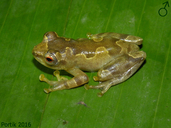|
Hyperolius sylvaticus Schiøtz, 1967
| family: Hyperoliidae genus: Hyperolius |
 © 2016 Daniel Portik (1 of 14) |
|
|
|
Description H. sylvaticus can be separated into three subspecies, characterised by the shape of the dorsal hourglass pattern and the size and character of the light dorsolateral stripes in phase F. The differences seem to be constant in available samples.
2. Hyperolius s. sylvaticus Schiøtz 1967. Small (Males 21–26 mm), phase J with coherent dorsal pattern, phase F with undelimited light dorsolateral stripe.
3. Hyperolius s. nigeriensis Schiøtz 1967. Rather large (males 24–29 mm), phase J with dorsal pattern broken mid-dorsally and with a dark, well delimited area behind eye; phase F with broad, dark-delimited dorsolateral stripe. The tadpole has the usual dentition, 1/1+1,2. The tail is very long (225–240% of body length), and with a low fin. Distribution and Habitat Country distribution from AmphibiaWeb's database: Cameroon, Cote d'Ivoire, Ghana, Nigeria
Life History, Abundance, Activity, and Special Behaviors The eggs are white with a green tinge, the jelly clear. Comments This account was taken from "Treefrogs of Africa" by Arne Schiøtz with kind permission from Edition Chimaira publishers, Frankfurt am Main.
References
Schiøtz, A. (1999). Treefrogs of Africa. Edition Chimaira, Frankfurt am Main. Originally submitted by: Arne Schiøtz (first posted 2001-01-09) Edited by: Kellie Whittaker (2008-09-10) Species Account Citation: AmphibiaWeb 2008 Hyperolius sylvaticus <https://amphibiaweb.org/species/591> University of California, Berkeley, CA, USA. Accessed Jun 1, 2025.
Feedback or comments about this page.
Citation: AmphibiaWeb. 2025. <https://amphibiaweb.org> University of California, Berkeley, CA, USA. Accessed 1 Jun 2025. AmphibiaWeb's policy on data use. |



 Map of Life
Map of Life